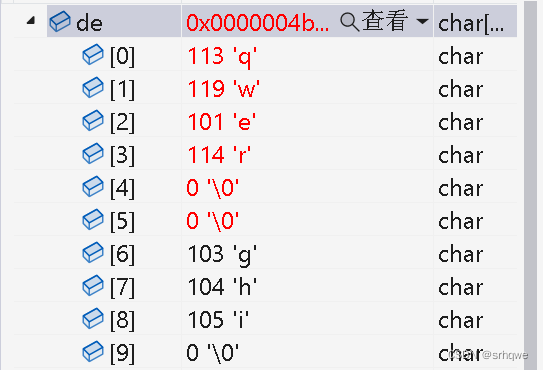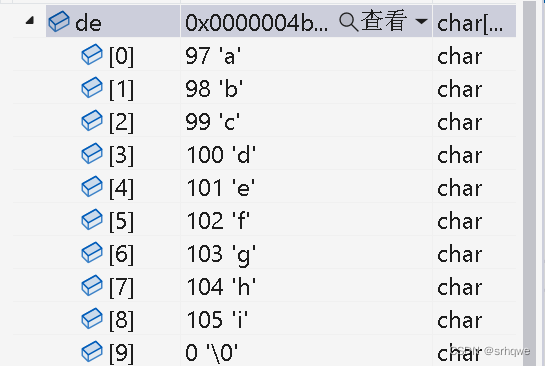C语言函数:字符串函数及模拟实现strncpy()、strncat()、strncmp()

C语言函数:字符串函数及模拟实现strncpy()、strncat()、strncmp()

在了解strncpy、strncat()、前,需要先了解strcpy()、strncat():
C语言函数:字符串函数及模拟实现strlen() 、strcpy()、 strcat()_srhqwe的博客-CSDN博客
strncpy():
作用:拷贝受限制长度的字符串,意思是:可以指定拷贝字符的个数到目标字符串内。
限制字符串个数是为了让程序相对安全,降低访问越界等情况出现的可能性。但是不会绝对安全,一个程序员要写bug如挥手一般简单.
参数部分:
char * __cdecl strncpy (char * dest,const char * source,size_t count)count是指定传入的个数。
#define _CRT_SECURE_NO_WARNINGS#include <stdio.h>int main()
{char de[20] = "abcdef";char so[] = "qwer";strncpy(de, so, 2);//拷贝2个字符printf("%s\\n", de);//结果:qwcdefreturn 0;
}当拷贝的字符串的个数超出原字符串的个数时,多出的部分会传\\0进去:

strncpy函数的实现:
在strcpy基础上,写strncpy并不难。
因此直接展示源码:
char * __cdecl strncpy (char * dest,const char * source,size_t count)
{char *start = dest;while (count && (*dest++ = *source++) != '\\0') /* copy string */count--;if (count) /* pad out with zeroes */while (--count)*dest++ = '\\0';return(start);
}
因为多了count用于控制长度,所以while循环也多了一个count:
当count不为0时,while循环继续。
直到count为0时,自动跳出。
(*dest++ = *source++) != '\\0') 和strcpy一样。其中!=\\0可以去掉。
当没有\\0时,dest和source一起++找下一个字符。
当在source找到\\0时,把\\0传入后while循环结束
if语句是为了保证count被置为0,因为count是我们需要拷贝的字符串个数。
就是上面所说的,如果超越了source本身的个数,会自动补\\0
最后return 最初的dest,即start
strncat():
作用:追加受限制的字符串。
参数部分:
char * __cdecl strncat (char * front,const char * back,size_t count)
int main()
{char de[20] = "abcd";char so[] = "qwer";strncat(de, so, 2);printf("%s\\n", de);//结果:abcdqwreturn 0;
}与strncpy一样,如果追加的个数超出so的范围呢?会和strcpy一样?
int main()
{char de[20] = "abcd";char so[] = "qwer";strncat(de, so, 6);printf("%s\\n", de);//结果:abcdqwerreturn 0;
}并不会,具体是怎么做的呢?那就先看看这个函数的实现:
strncat的实现:
strncat的源码:
char * __cdecl strncat (char * front,const char * back,size_t count)
{char *start = front;while (*front++);front--;while (count--)if ((*front++ = *back++) == 0)return(start);*front = '\\0';return(start);
}第一个while循环,和strcat一样,先找到front的\\0,然后从\\0开始向后追加。
第二个while循环,count--作为条件语句,意思是循环count次,从而可以保证追加的个数。
while循环的if语句,是从front的\\0开始向后追加back的元素,当在back中遇到是\\0时,==0,那么就直接返回。因此如果追加的个数超出范围,不会追加\\0,而是直接返回。
当count==0时,while循环退出,说明目前为止,已经把想传入的字符串传完了,因为上面是后置++,所以此时的front已经指向了最后一个元素的后面的指针。所以直接将此时指针指向的front的元素改成\\0,即: *front = '\\0';
最后return 原front地址
strncmp():
在了解strncmp()前,需要先了解strcmp():
C语言函数:字符串函数及模拟实现strcmp()_srhqwe的博客-CSDN博客
作用:对比受限制的两串字符串
strncmp和strcmp其实相差并不大,只是限制了对比的范围。返回值与strcmp是一样的
参数部分:
int __cdecl strncmp (const char *first,const char *last,size_t count )
#define _CRT_SECURE_NO_WARNINGS#include <stdio.h>int main()
{char de[20] = "abcd";char so[] = "aba";strncmp(de, so, 3);printf("%s\\n", de);//结果:1return 0;
}输入3比较的就是de和so的前三个字符
#define _CRT_SECURE_NO_WARNINGS#include <stdio.h>int main()
{char de[20] = "abad";char so[] = "aba";int ret = strncmp(de, so, 7);printf("%d\\n",ret );//结果:1return 0;
}即使输入的数字超出了两个字符串的个数也没事,因为往后比较的都是\\0。与strcmp基本一致。
strncmp()函数的实现:
strncmp函数源码:
int __cdecl strncmp
(const char *first,const char *last,size_t count
)
{size_t x = 0;if (!count){return 0;}if( count >= 4 ){/* unroll by four */for (; x < count-4; x+=4){first+=4;last +=4;if (*(first-4) == 0 || *(first-4) != *(last-4)){return(*(unsigned char *)(first-4) - *(unsigned char *)(last-4));}if (*(first-3) == 0 || *(first-3) != *(last-3)){return(*(unsigned char *)(first-3) - *(unsigned char *)(last-3));}if (*(first-2) == 0 || *(first-2) != *(last-2)){return(*(unsigned char *)(first-2) - *(unsigned char *)(last-2));}if (*(first-1) == 0 || *(first-1) != *(last-1)){return(*(unsigned char *)(first-1) - *(unsigned char *)(last-1));}}}/* residual loop */for (; x < count; x++){if (*first == 0 || *first != *last){return(*(unsigned char *)first - *(unsigned char *)last);}first+=1;last+=1;}return 0;
}
第一个if语句,如果count==0那么就不用比较了,因为比较的区间没有。
第二个if语句只是将区间划分成[0,4]和(4,正无穷)讨论
之后的语句就是把每个每个字符进行比较,返回比较的结果。



